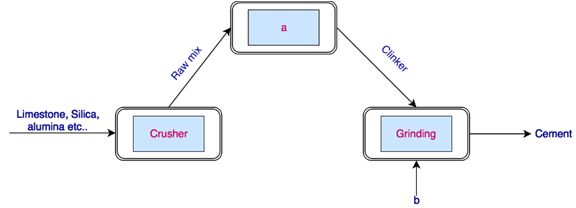This set of Basic Civil Engineering Multiple Choice Questions & Answers (MCQs) focuses on “Manufacture of Cement”.
1. Nowadays, wet method of cement manufacturing is used.
a) True
b) False
View Answer
Explanation: Wet method was used from 1913 to 1960. The dry method is most adopted because it improves the quality of cement, utilizing less power.
2. In the figure below, what does ‘a’ represents?

a) Combustion chamber
b) Wash mill
c) Kiln
d) Dryer
View Answer
Explanation: After the raw materials are mixed thoroughly, they need to be burned. Hence, ‘a’ in the figure stands for kiln.
3. In the same figure in question 2, what is ‘b’ and its function?
a) Water-plasticity
b) Lime-strength
c) Sulphur-soundness
d) Gypsum-control setting
View Answer
Explanation: During the grinding process, small amount of gypsum is added. It is done to control the setting of cement.
4. How is the argillaceous material used in the manufacture of cement stored?
a) Silos
b) Basins
c) Bags
d) Storage tanks
View Answer
Explanation: Clay is the argillaceous material used. These are mixed with water thoroughly and washed in a container-wash mill. The wet mixture is then stored in basins.
5. Which one of the below is rarely used as fuel in burning stage of wet process of cement manufacturing?
a) Wood
b) Gas
c) Pulverised coal
d) Fuel oil
View Answer
Explanation: Clinkers are formed at a temperature of 1450o c. Wood burns at a temperature of 593oc, natural gas at 2000oc, coal at 3500oc and oil at 2150oc. Wood cannot offer higher temperature at lower cost, time and energy.
6. How much does a bag of cement weigh?
a) 1 kg
b) 25 kg
c) 50 kg
d) 35 kg
View Answer
Explanation: The weight of one bag of cement is 50 kg everywhere. It is the standard measurement. In the manufacturing unit of cement, it is packed in bags of 50kg.
7. What is released during the production of clinker?
a) CaCO3
b) CO2
c) Ca(OH)2
d) CO
View Answer
Explanation: Specifically, CO2 is released during calcination of limestone, which goes on to form clinkers ahead. It occurs in upper, cooler end of kiln (precalciner) at temperatures of 600-900oc.
8. What is the advantage of using precalciner?
a) Fine grained cement
b) Larger clinker size
c) Fuel efficiency
d) Sound cement
View Answer
Explanation: Almost 95% of calcination is completely over in the precalciner, if 50-60% of fuel is added to this chamber. Hence fuel in the kiln required is less.
9. Which stone provides the calcareous component required for the manufacture of cement?
a) Lime
b) Limestone
c) Marble
d) Granite
View Answer
Explanation: Calcareous component used for cement manufacture is calcium carbonate. It is obtained by quarrying limestone.
10. Shale provides argillaceous components required for cement manufacture process.
a) True
b) False
View Answer
Explanation: Quarrying shale stone gives the argillaceous component. These are silica, aluminium and iron.
11. Which one of the below is not a feature of cement Kiln?
a) Employs alternate fuels
b) Natural alkaline environment
c) High temperature
d) Portable
View Answer
Explanation: Cement kiln is highly efficient as it incorporates preheater, precalciner, uses alternative fuels-bio fuels, recycled waste, etc. It requires space and is permanently installed in one place. Rotary kiln is the one that is portable.
Sanfoundry Global Education & Learning Series – Basic Civil Engineering.
To practice all areas of Basic Civil Engineering, here is complete set of 1000+ Multiple Choice Questions and Answers.
If you find a mistake in question / option / answer, kindly take a screenshot and email to [email protected]
